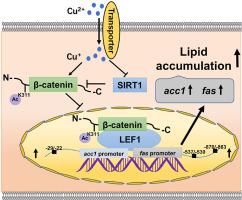当前位置:
X-MOL 学术
›
Environ. Pollut.
›
论文详情
Our official English website, www.x-mol.net, welcomes your
feedback! (Note: you will need to create a separate account there.)
Waterborne Cu exposure increased lipid deposition and lipogenesis by affecting Wnt/β-catenin pathway and the β-catenin acetylation levels of grass carp Ctenopharyngodon idella.
Environmental Pollution ( IF 7.6 ) Pub Date : 2020-03-27 , DOI: 10.1016/j.envpol.2020.114420 Yi-Chuang Xu 1 , Yi-Huan Xu 1 , Tao Zhao 1 , Li-Xiang Wu 1 , Shui-Bo Yang 1 , Zhi Luo 2
Environmental Pollution ( IF 7.6 ) Pub Date : 2020-03-27 , DOI: 10.1016/j.envpol.2020.114420 Yi-Chuang Xu 1 , Yi-Huan Xu 1 , Tao Zhao 1 , Li-Xiang Wu 1 , Shui-Bo Yang 1 , Zhi Luo 2
Affiliation

|
Lipid metabolism could be used as a biomarker for environmental monitoring of metal pollution, including Cu. Given the potential role of the Wnt/β-catenin signaling pathway and acetylation in lipid metabolism, the aim of this study was to investigate the mechanism of Wnt signaling and acetylation mediating Cu-induced lipogenesis. Grass carp Ctenopharyngodon idella, widely distributed freshwater teleost, were used as the model. We found that waterborne Cu exposure increased the accumulation of Cu and lipid, up-regulated lipogenesis, suppressed Wnt signaling, reduced β-catenin protein level and its nuclear location, reduced the sirt1 mRNA levels and up-regulated the β-catenin acetylation level. Further investigation found that Cu up-regulated lipogenesis through Wnt/β-catenin pathway; Cu regulated the β-catenin acetylation, and K311 was the key acetylated residue after Cu incubation. SIRT1 mediated Cu-induced changes of acetylated β-catenin and played an essential role in nuclear accumulation of β-catenin and Cu-induced lipogenesis. Cu facilitated lipid accumulation via the regulation of Wnt pathway by SIRT1. For the first time, our study uncovered the novel mechanism for Wnt/β-catenin pathway and β-catenin acetylation levels mediating Cu-induced lipid deposition, which provided insights into the association between Cu exposure and lipid metabolism in fish and had important environmental implications for monitoring metal pollution in the water by using new biomarkers involved in lipid metabolism.
中文翻译:

暴露于水中的铜通过影响草鱼Ctenopharyngodon idella的Wnt /β-catenin途径和β-catenin乙酰化水平来增加脂质沉积和脂肪生成。
脂质代谢可以用作环境监测金属污染(包括铜)的生物标记。考虑到Wnt /β-catenin信号通路和乙酰化在脂质代谢中的潜在作用,本研究的目的是研究Wnt信号和乙酰化介导Cu诱导的脂肪形成的机制。以广泛分布的淡水硬骨鱼草鱼Ctenopharyngodon idella为模型。我们发现水性铜暴露增加了铜和脂质的积累,上调了脂肪生成,抑制了Wnt信号传导,降低了β-catenin蛋白水平及其核位置,降低了sirt1 mRNA水平并上调了β-catenin乙酰化水平。进一步的研究发现,铜通过Wnt /β-catenin途径上调脂肪形成。铜调节β-连环蛋白的乙酰化,Cu孵育后K311是关键的乙酰化残基。SIRT1介导Cu诱导的乙酰化β-catenin的变化,并在β-catenin的核积累和Cu诱导的脂肪形成中起重要作用。铜通过SIRT1调控Wnt途径促进脂质蓄积。我们的研究首次揭示了Wnt /β-catenin途径和β-catenin乙酰化水平介导Cu诱导的脂质沉积的新机制,这为了解Cu暴露与鱼类脂质代谢之间的关联提供了见识,并具有重要的环境意义。通过使用参与脂质代谢的新生物标记来监测水中的金属污染。SIRT1介导Cu诱导的乙酰化β-catenin的变化,并在β-catenin的核积累和Cu诱导的脂肪形成中起重要作用。铜通过SIRT1调控Wnt途径促进脂质蓄积。我们的研究首次揭示了Wnt /β-catenin途径和β-catenin乙酰化水平介导Cu诱导的脂质沉积的新机制,这为了解Cu暴露与鱼类脂质代谢之间的关联提供了见解,并具有重要的环境意义。通过使用参与脂质代谢的新生物标记来监测水中的金属污染。SIRT1介导Cu诱导的乙酰化β-catenin的变化,并在β-catenin的核积累和Cu诱导的脂肪形成中起重要作用。铜通过SIRT1调控Wnt途径促进脂质蓄积。我们的研究首次揭示了Wnt /β-catenin途径和β-catenin乙酰化水平介导Cu诱导的脂质沉积的新机制,这为了解Cu暴露与鱼类脂质代谢之间的关联提供了见识,并具有重要的环境意义。通过使用参与脂质代谢的新生物标记来监测水中的金属污染。
更新日期:2020-04-20
中文翻译:

暴露于水中的铜通过影响草鱼Ctenopharyngodon idella的Wnt /β-catenin途径和β-catenin乙酰化水平来增加脂质沉积和脂肪生成。
脂质代谢可以用作环境监测金属污染(包括铜)的生物标记。考虑到Wnt /β-catenin信号通路和乙酰化在脂质代谢中的潜在作用,本研究的目的是研究Wnt信号和乙酰化介导Cu诱导的脂肪形成的机制。以广泛分布的淡水硬骨鱼草鱼Ctenopharyngodon idella为模型。我们发现水性铜暴露增加了铜和脂质的积累,上调了脂肪生成,抑制了Wnt信号传导,降低了β-catenin蛋白水平及其核位置,降低了sirt1 mRNA水平并上调了β-catenin乙酰化水平。进一步的研究发现,铜通过Wnt /β-catenin途径上调脂肪形成。铜调节β-连环蛋白的乙酰化,Cu孵育后K311是关键的乙酰化残基。SIRT1介导Cu诱导的乙酰化β-catenin的变化,并在β-catenin的核积累和Cu诱导的脂肪形成中起重要作用。铜通过SIRT1调控Wnt途径促进脂质蓄积。我们的研究首次揭示了Wnt /β-catenin途径和β-catenin乙酰化水平介导Cu诱导的脂质沉积的新机制,这为了解Cu暴露与鱼类脂质代谢之间的关联提供了见识,并具有重要的环境意义。通过使用参与脂质代谢的新生物标记来监测水中的金属污染。SIRT1介导Cu诱导的乙酰化β-catenin的变化,并在β-catenin的核积累和Cu诱导的脂肪形成中起重要作用。铜通过SIRT1调控Wnt途径促进脂质蓄积。我们的研究首次揭示了Wnt /β-catenin途径和β-catenin乙酰化水平介导Cu诱导的脂质沉积的新机制,这为了解Cu暴露与鱼类脂质代谢之间的关联提供了见解,并具有重要的环境意义。通过使用参与脂质代谢的新生物标记来监测水中的金属污染。SIRT1介导Cu诱导的乙酰化β-catenin的变化,并在β-catenin的核积累和Cu诱导的脂肪形成中起重要作用。铜通过SIRT1调控Wnt途径促进脂质蓄积。我们的研究首次揭示了Wnt /β-catenin途径和β-catenin乙酰化水平介导Cu诱导的脂质沉积的新机制,这为了解Cu暴露与鱼类脂质代谢之间的关联提供了见识,并具有重要的环境意义。通过使用参与脂质代谢的新生物标记来监测水中的金属污染。











































 京公网安备 11010802027423号
京公网安备 11010802027423号